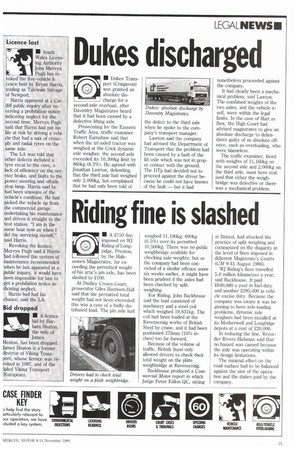Riding fine is slashed
Page 23

If you've noticed an error in this article please click here to report it so we can fix it.
• A 2750 fine imposed on 'NJ Riding of Longridge, Preston, by the Halesowen Magistrates, for exceeding the permitted weight of his attic's pin axle, has been slashed to 2100.
At Dudley Crown Court, prosecutor Giles Harrison-Hall said that the permitted total weight had not been exceeded: this was a case of a badly distributed load. The pin axle had weighed 11,190kg; 690kg (6.5%) over its permitted 10,500kg. There was no public weighbridge available for checking axle weights, but as the company had been convicted of a similar offence some six weeks earlier, it might have been prudent if the axles had been checked by split weighing.
For Riding, John Backhouse said the load consisted of machinery and a steel coil which weighed 19,831kg. The coil had been loaded at the Ravenscraig works of British Steel by crane, and it had been positioned 273nun (1034 inches) too far forward.
Because of the volume of traffic, British Steel only allowed drivers to check their total weight on the plate weighbridge at Ravenscraig.
Backhouse produced a Commercial Motor report in which Judge Peter Fallon QC, sitting
at Bristol, had attacked the practice of split weighing and commented on the disparity in the level of fines imposed in different Magistrate's Courts (CM 9-15 August 1986).
WJ Riding's fleet travelled 5.6 million kilometres a year, said Backhouse. It paid £840,880 a year in fuel duty and another 2295,000 in vehicle excise duty. Because the company was aware it was beginning to have axle-loading problems, dynamic axle weighers had been installed at its Motherwell and Longridge depots at a cost of 220,000.
In reducing the fine, Recorder Rivers Hickman said that no hazard was caused because the axle was operating within its design limitations.
The minimal effect on the road surface had to be balanced against the size of the operation and the duties paid by the company.




























































































































